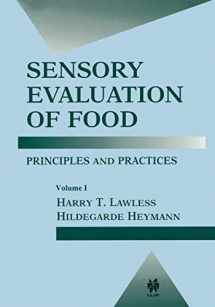
Sensory Evaluation of Food: Principles and Practices (Food Science Texts Series)
ISBN-13:
9780412994418
ISBN-10:
0412994410
Edition:
1999
Author:
Harry T. Lawless, Hildegarde Heymann
Publication date:
1998
Publisher:
Chapman & Hall
Format:
Hardcover
827 pages
FREE US shipping
Book details
ISBN-13:
9780412994418
ISBN-10:
0412994410
Edition:
1999
Author:
Harry T. Lawless, Hildegarde Heymann
Publication date:
1998
Publisher:
Chapman & Hall
Format:
Hardcover
827 pages
Summary
Sensory Evaluation of Food: Principles and Practices (Food Science Texts Series) (ISBN-13: 9780412994418 and ISBN-10: 0412994410), written by authors
Harry T. Lawless, Hildegarde Heymann, was published by Chapman & Hall in 1998.
With an overall rating of 3.8 stars, it's a notable title among other
books. You can easily purchase or rent Sensory Evaluation of Food: Principles and Practices (Food Science Texts Series) (Hardcover) from BooksRun,
along with many other new and used
books
and textbooks.
And, if you're looking to sell your copy, our current buyback offer is $0.3.
Description
The field of sensory evaluation has matured in the last half century to be come a recognized discipline in the food and consumer sciences and an important part of the foods and consumer products industries. Sensory pro fessionals enjoy widespread recognition for the important services they provide in new product development, basic research, ingredient and process modification, cost reduction, quality maintenance, and product op timization. These services enhance the informational support for manage ment decisions, lowering the risk that accompanies the decision-making process. From the consumers' perspective, a sensory testing program in a food or consumer products company helps ensure that products reach the market with not only good concepts but also with desirable sensory attrib utes that meet their expectations. Sensory professionals have advanced weil beyond the stage when they were simply called on to execute "taste" tests and to provide statistical summaries of results. They are now frequently asked to partleipale in the decision process itself, to draw reasoned conclusions based on data, and to make recommendations. They arealso expected tobe weil versed in an in creasingly sophisticated battery of test methods and statistical procedures, including multivariate analyses. As always, sensory professionals also need to understand people, for people are the measuring instruments that provide the basic sensory data. People are notoriously variable and diffi cult to calibrate, presenting the sensory specialist with many additional XV :xvi PREFACE measurement problems that are not present in instrumental methods.


We would LOVE it if you could help us and other readers by reviewing the book
Book review

Congratulations! We have received your book review.
{user}
{createdAt}
by {truncated_author}


